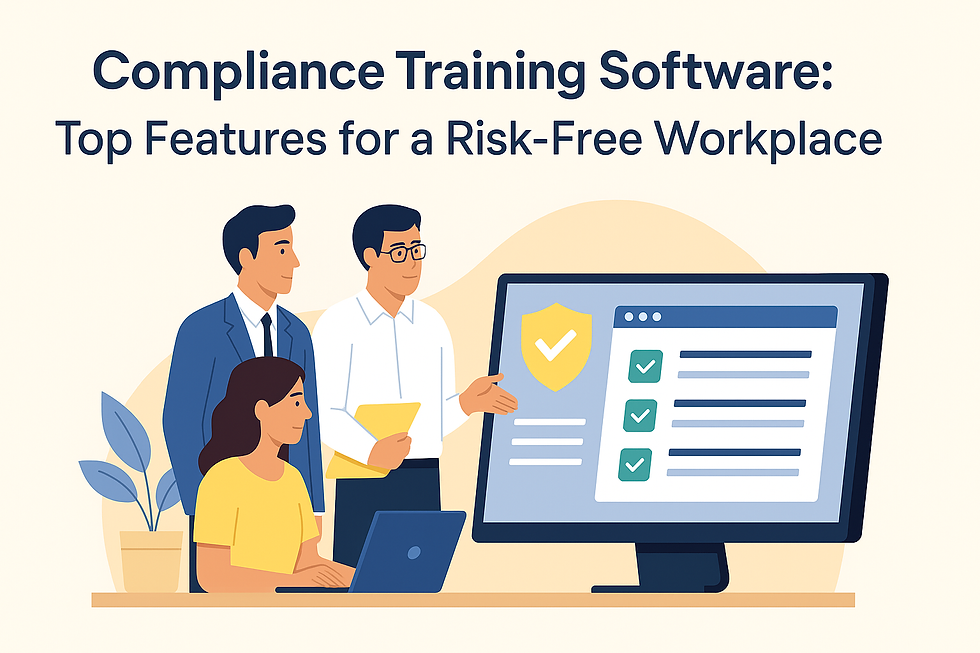Compliance Training Software: Top Features for a Risk-Free Workplace
- Alisa Herman
- Jun 20
- 3 min read

Introduction
In an age of rising regulatory scrutiny, one data breach or non-compliance incident can trigger massive consequences—legal, financial, and reputational. Businesses cannot afford to treat compliance training as a once-a-year checkbox exercise. It must be ongoing, trackable, and tailored.
This is where compliance training software plays a crucial role. A robust platform not only keeps your organisation audit-ready, but also creates a culture of awareness, accountability, and risk reduction.
In this blog, we explore the key features your compliance training software should include to build a truly risk-free workplace—while making learning efficient and engaging for your team.
Why Compliance Training Software Matters More Than Ever
Compliance regulations are constantly evolving. Whether it is GDPR, OSHA, HIPAA, SOC 2, or industry-specific standards, the cost of falling behind is steep. Manual tracking and outdated processes expose companies to:
Audit failures
Fines and penalties
Data breaches
Reputational damage
Legal action from clients or regulators
Modern compliance software turns reactive training into proactive risk management—without burdening HR or legal teams with endless spreadsheets and reminders.
1. Automated Certification Tracking and Renewal Reminders
This is non-negotiable.
Your software should:
Assign mandatory training automatically
Track when certificates expire
Alert both employees and managers before deadlines
Generate proof of certification on demand
Without automated tracking, missed renewals are inevitable—and regulators are rarely forgiving.
2. Role-Based Course Assignments
Not everyone needs the same training.
Your platform should allow you to assign:
Security training for engineers
Anti-harassment for managers
HIPAA modules for healthcare workers
GDPR compliance for marketing teams
Role-based paths reduce learner fatigue and ensure each employee is only seeing relevant content—improving both completion and retention rates.
3. Real-Time Reporting and Audit Trails
Whether you are preparing for a regulatory audit or simply want internal visibility, your LMS must provide:
Real-time dashboards of completion status
Exportable audit reports
Timestamped records of completions and quiz scores
Manager-level views by department, location, or team
This gives you control, proof, and confidence in your compliance posture.
4. E-Signatures and Policy Acknowledgements
Many compliance modules require more than learning—they require legal attestation.
Your software should:
Attach signed acknowledgements to each course
Store signed records securely
Allow electronic policy distribution
Capture updates and version history of policy documents
This ensures you can prove not just training, but explicit agreement with organisational expectations.
5. Microlearning for High-Risk Topics
Long lectures are often ignored.
Delivering compliance content as bite-sized, scenario-based lessons makes it:
Easier to understand
More memorable
Less disruptive to workflows
More likely to be completed
Example: Instead of a 45-minute course, break it into three 10-minute segments with a follow-up quiz.
6. Mobile-Optimised Learning
Your compliance program must meet employees where they are.
A mobile-optimised LMS allows employees to:
Complete training from their phone
Download content for offline access
Get push reminders for overdue tasks
This is especially useful for field teams, contractors, or remote workers who are not always at a desk.
7. Integration with HR and Identity Systems
Compliance training is more effective when integrated with your HR and IT stack.
Look for:
Integration with HRIS (e.g., BambooHR, Workday)
Single sign-on (SSO) to reduce password fatigue
API access for custom triggers (e.g., new hire auto-enrolment)
These features streamline user management, improve security, and save hours of admin work.
8. Quiz-Based Knowledge Validation
Completion does not always equal understanding.
Use quizzes to:
Validate learning outcomes
Identify areas needing further coaching
Capture data for training effectiveness metrics
Bonus: Include scenario-based questions to simulate real-world application and reinforce critical thinking.
9. Compliance Dashboards for Managers
Your software should not just support HR—it must empower team managers too.
Enable department heads to:
See training progress at a glance
Get alerts for team members who are non-compliant
Assign department-specific content
View historical records for audits or coaching
This decentralises ownership and ensures compliance accountability at every level.
10. Legal and Regulatory Content Libraries
Choosing a platform that offers pre-built, up-to-date training libraries can save time and legal risk.
Look for:
Region-specific legal modules (e.g., CCPA vs GDPR)
Industry-specific content (e.g., food safety, financial ethics)
Multilingual options for global teams
Expert-reviewed material that updates with regulation changes
Final Thoughts
The best compliance training software is not just about checkboxes—it is about building a proactive, resilient organisation.
By investing in features like automation, personalisation, real-time reporting, and mobile access, you turn compliance from a burden into a strength.
If you want a platform that offers all of the above and more, SkyPrep is worth exploring. With tools for automated enrolment, certificate tracking, reporting, policy attestation, and custom learning paths, SkyPrep helps businesses stay one step ahead of risk—while keeping compliance training smooth, scalable, and effective.
Because when it comes to compliance, failure is not an option—and with the right software, success is the standard.






Commentaires